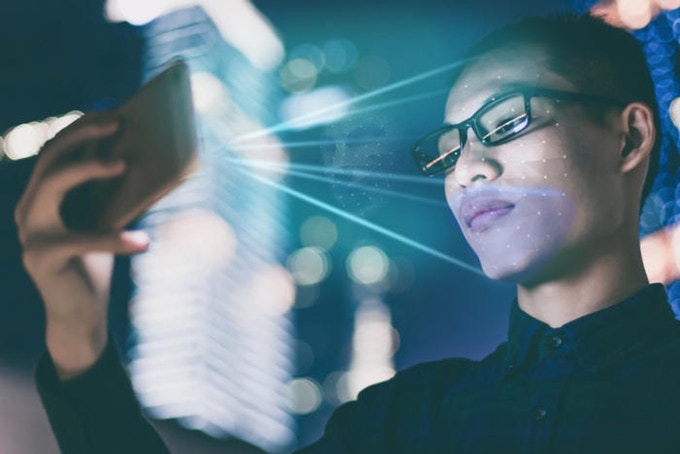Bloomberg:
Sources: Infineon nears deal to buy Cypress Semiconductor for $23-$24/share; the San Jose-based chipmaker had market cap of $6.5B and closed at $17.82 on Friday — - Transaction likely to value Cypress at $10 billion with debt — German chipmaker could pay $23 to $24 per share for Cypress
Tech Nuggets with Technology: This Blog provides you the content regarding the latest technology which includes gadjets,softwares,laptops,mobiles etc
Sunday, June 2, 2019
Sources: Infineon nears deal to buy Cypress Semiconductor for $23-$24/share; the San Jose-based chipmaker had market cap of $6.5B and closed at $17.82 on Friday (Bloomberg)
How Huawei’s pain may be Samsung and Apple’s gain
Walmart expects ease of doing business in India to get easier
Apple WWDC 2019 Starts Today: Here's How to Watch Keynote Live Stream
UC Browser pivots to short-form content
A growing number of youngsters keep off social media as they see it addictive, productivity killer
Google’s Cloud outage is resolved, but it reveals the holes in cloud computing’s atmosphere
Five hours after Google publicly announced that it was working to resolve an outage in its Cloud computing network that had taken out a large chunk of Google services as well as Shopify, Snap, Discord and other popular apps, the problem seems to be resolved.
The outage hit everything from the ability to control the temperature in people’s homes and apartments through Google’s Nest to shopping on any service powered by Shopify, to Snapchat and Discord’s social networks.
“The network congestion issue in eastern USA, affecting Google Cloud, G Suite, and YouTube has been resolved for all affected users as of 4:00pm US/Pacific,” the company said in a statement.
“We will conduct an internal investigation of this issue and make appropriate improvements to our systems to help prevent or minimize future recurrence. We will provide a detailed report of this incident once we have completed our internal investigation. This detailed report will contain information regarding SLA credits.”
Even though the networking issue has been resolved, the fact that problems with Google’s cloud services could cause outages for several of the world’s most popular applications underscores how thin cloud coverage can be for modern computing architectures.
Most companies have put their entire backend in the hands of one company and while the benefits outweigh the risks most of the time, it’s worthwhile to at least think about contingency planning.
Modern cloud architectures have slashed the cost of creating new technology businesses, but it also means that companies are typically dependent on one service for their ability to operate.
As the world becomes more networked (especially as internet-enabled devices become more prevalent in the home), it’s going to be more important for companies to have a back-up plan in place in case these services go down.
In short, it’s fine to have a dependency — like storage or computing in the cloud — just as long as companies have a way to account for their dependents.
Nokia 62 with 46MP camera could be announced on Thursday
After bringing the Nokia 4.2 and Nokia 3.2 to the Indian smartphone market earlier this year, Nokia brand owner HMD Global Oy seems poised to launch the Nokia 6.2. The Finnish smartphone maker posted a teaser video on Twitter yesterday in which only the curved edge of a glossy smartphone is seen. The detail it reveals is the presence of a 3.5mm jack. “#GetAhead with a sleek design & customizability. Stay tuned!” wrote Nokia, in the tweet's caption. Nokia also suggested that more information would be revealed to the public on June 6.
In all probability HMD Global Oy is preparing to launch the Nokia 6.2, a mid-range smartphone known in other markets as the Nokia X71. The phone was first announced in Taiwan in early April with three cameras on the back panel, one of which was a 48-megapixel sensor. According to an online tipster, the Nokia 6.2 is expected to cost approximately Rs 20,150 at the time of launch. Since it's not confirmed by Nokia, we suggest you view that figure with the difference of a couple of thousands here or there.
The Nokia 6.2 is expected to be powered by a Qualcomm Snapdragon 660 chipset with an octa-core processor and 6GB of RAM. The phone should run Android 9 Pie out of the box and receive regular software updates for up to two years after launch, thanks to Google's Android One programme. On a Geekbench Browser listing that we recently spotted, the Nokia 6.2 scored 1455 on the Single-Core test and 5075 on the Multi-Core test. In comparison, the recently launched Xiaomi Redmi Note 7 powered by the same chipset scores 1642 and 5796 on the same two tests respectively.
The Nokia 6.2 is expected to be aimed at photography enthusiasts. What we know so far about the device is that it has three cameras on the back panel, one of which is a 48-megapixel sensor made either by Sony or Samsung. The other two should take on wide-angle photography and depth sensing tasks. Internal storage is expected to be 128GB with the option of expanding it to 256GB using a microSD card. The battery on it is said to be a 3,500mAh unit with an 18W fast-charging setup. At any rate, all of this should be confirmed on Thursday.
#GetAhead with a sleek design & customizability. Stay tuned! http://bit.ly/2KqiUiB
Redmi K20 may be rebranded as the Mi 9T in global markets based retail box leaks
There’s a certain Xiaomi Mi9T that has been leaked in a few images that shows its retail box. Many are assuming this is what the Redmi K20 will be rebranded to in markets outside China. The upcoming phone is already being teased on social media channels by the company. One of the images have surfaced on Weibo, while the other two have been leaked by a Dubai-based YouTuber.
All the three images of the phone show the front part of the alleged Mi 9T where the screen is stretching to the edges indicating the front camera will be put inside a pop-up module like in the Redmi K20 and the Redmi K20 Pro. This is what has led to the belief that this could be the rebranded version of the Redmi K20.
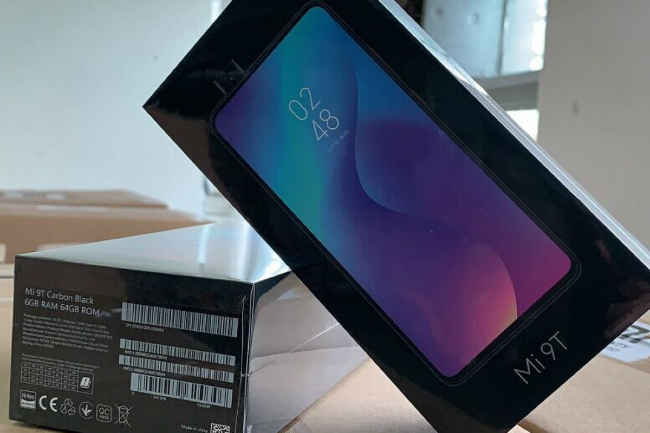
The Weibo image shows the retail box of the upcoming smartphone. The Mi 9T will reportedly come in a Carbon Black variant with 6GB RAM and 64GB storage. The box shows a render of the phone along with the Mi 9T branding. The render also shows the pop-up selfie camera.
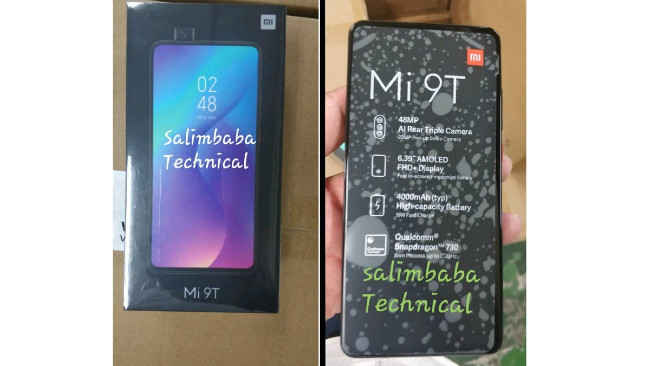
The renders in the box as well as the photos shared by the Dubai-based blogger is in line with the photos of the Redmi K20. Earlier rumours that the Redmi K20 and the Redmi K20 Pro will debut outside China as the Mi 9T and Mi 9T Pro respectively, also bolstered the claims.
The image shared by the Dubai-based blogger shows a screen-guard of the device that has the specs written down. Based on that, the phone will have a 6.39-inch AMOLED display, in-display fingerprint sensor, 20MP pop-up front camera, and a 4000mAh battery with 18W fast charging support. Finally, the chipset is likely going to be the Qualcomm Snapdragon 730.
There isn’t much information officially known about the upcoming Mi 9T. A teaser on social media has confirmed the name and the bezel-less display. The phone recently received NBTC certification in Thailand as well as NCC certification in Taiwan. There are also rumours that the Mi 9T is going to be unveiled in Russia later this month, and based on the latest leak, it could come to Dubai as well. But nothing is known as of now about the company’s plan for an India launch.
Huawei asks Foxconn to cut down on phone production following US ban: Report
Huawei’s US ban might stretch for a long time and the Chinese smartphone giant is now scaling back its production according to a report by South China Morning Post. Huawei has reportedly asked Foxconn to stop “several” lines of production in response to the US government’s ban on US companies to do business with Huawei. The world’s second largest smartphone manufacturer was accused of installing backdoors in their devices to allow Chinese officials to spy on US citizens.
The report doesn’t mention whether the halt in production is long term or shot-term, but it comes just months after Foxconn went on a hiring spree to accommodate growing demands for Huawei phones.
If the report is indeed true, Huawei could come into a staggering halt in its ambition to become the world’s largest smartphone brand. The company is anyway in a tight spot after both Google and ARM announced they will be cutting ties with the company. Without Google’s services, Hauwei might be unable to ship Android phones in markets outside China. Huawei’s semiconductor division is also expected to hurt badly since it relies on ARM’s micro architecture licenses to design its HiSilicon Kirin chipsets.
The report states that Huawei is now closely observing and evaluating the situation, according to Zhao Ming, the president of Honor, a Huawei sub-brand at a media briefing in Shanghai, China.
“As the new situation has emerged, it is too early to say whether we are able to achieve the goal,” Zhao said when asked about Huawei’s plans to overtake Samsung in 2019.
Huawei and its subsidiares are presently placed on a trade blacklist that restricts Huawei from buying products and services from US companies without the country’s approval. After the announcement of the ban, US giants like Intel, Qualcomm, Broadcomm, and Google have reportedly told their employees not to supply products and services to Huawei anymore, which is expected to seriously cripple Huawei’s growth in the smartphone market.
Apple's Dark Mode, despite marketing claims, is at odds with the science of human visual perception and affects productivity by making it harder to read text (Adam Engst/TidBITS)
Adam Engst / TidBITS:
Apple's Dark Mode, despite marketing claims, is at odds with the science of human visual perception and affects productivity by making it harder to read text — Dark Mode is the marquee feature of macOS 10.14 Mojave. Apple even gives it the top spot on the macOS product page, saying:
Week-in-Review: Apple’s shipping a refresh for its worst device, but why?
Hello, weekend warriors. This is Week-in-Review where I get hopped up on caffeine and scour the hundred of stories that emerged on TechCrunch this week and surface my favorites for your reading pleasure.
First, an update on my newsletter last week: I dove into Trump’s Huawei ban and talked about some of the ill effects it could spell for American tech companies caught in the fray. Well, it looks like China is starting to build a list of “unreliable” foreign firms, most likely the partners that are severing ties with Huawei. This might just be a preliminary step, but I’m sure U.S. companies on the list won’t be psyched to be at the frontlines of a massive trade war/ tech cold war…
Onto this week’s topic, which is a new iPod from Apple. There’s really not much to it, it’s an iPod Touch with an A10 chipset, so why do I think this was even vaguely interesting?

Nobody was expecting an update for this device, it hadn’t been updated since 2015 and it remains Apple’s last pocketable mobile device without access to a mobile network. It’s the dumbest device Apple sells — a total anomaly — so why throw it a new refresh? As with every perplexing move that Apple makes lately, it comes down to how the Cupertino giant is acquiring customers and making revenue in 2019.
It doesn’t take much scouring through Apple’s marketing materials to understand who the new iPod Touch is for, the answer hits you in the face, it’s for kids. It’s a starter iPhone.
The company needs to wrench more revenue from high-value users buying their most expensive devices, but that equation doesn’t bode well for the youngest Apple users getting their first device. When the iPod Touch was last refreshed in 2015, the iPhone 6S had just been announced and 2-year carrier contract deals meant you could get your hands on one for $199. That’s not the case anymore.
In 2016, an oft-quoted study declared 10.3-years-old as the average age that kids got their first smartphone, there hasn’t been anything too serious done since then but it’s not unreasonable to suspect that number has gone anywhere but down. Parents are likely already on the fence about taking the plunge on the device that comes even earlier than a smartphone and devices running Android are cheaper and more plentiful. While Apple has maintained the $329 entry price of the iPad, the iPad Mini has jumped in price and the higher-end iPads are more expensive than ever.
The crazy thing is that as Apple and Google’s cloud services are getting more sand-boxed, it’s becoming more and more likely that these first devices could determine what operating system a kid sticks with once they have more of a say in what smartphone they’re getting. Where are their photos stored? What can they play the games they’ve already bought? At a certain point, will higher upfront costs for these entry-level devices hamper iOS growth further down the road?
Shoot me tips or feedback
on Twitter @lucasmtny or email
lucas@techcrunch.com
It’s all just an interesting head-scratcher, but more fundamentally while Apple is trying to wrench more cash out of its hardware acolytes, it still can’t afford to shy away from low-cost devices that entice people into high-cost services. In this way its torn between two strategies, and left in this strange evolutionary stage where it has to ensure it doesn’t screw itself over down the road.
Something like Apple Arcade could theoretically be a great sell for parents, games can be played offline and there are none of the pesky in-app purchases, but that only works when the parents aren’t buying a bargain Android tablet in the first place.
We’ll see how much Apple continues to support older hardware with its iOS 13 release Monday, but we’ll also see how much they continue to build out features and products to get kids engaged with Apple and iOS earlier and earlier. Likely with the goal of keeping them away from the cheap stuff that their skyrocketing hardware prices might push them towards.
What to expect at Apple’s WWDC 2019
On to the rest of the week’s news…
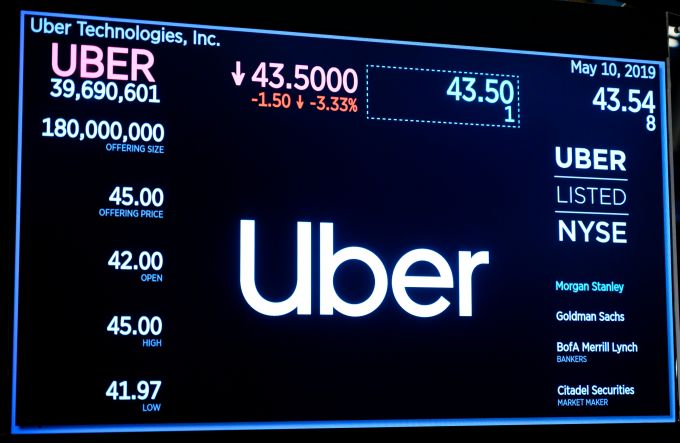
JOHANNES EISELE/AFP/Getty Images
Trends of the week
Here are a few big news items from big companies, with green links to all the sweet, sweet added context.
- Your Uber rating is: go order a Lyft
Every Uber driver has a horror story and there’s a decent chance that for a lot of Uber drivers those horror stories involve some of the same riders. The company announced this week that they’re just straight-up banning some of the lowest-rated users, though it sounds like you’ll get a few warnings to clean up your act before any action takes place. Previously, drivers have faced potential deactivations if they drop below a 4.6 rating, but there’s no specific word on what the threshold is for unruly riders. - RIP: BBM
This generation of tech giants has been riding high for the better part of the past decade, but it’s important to remember that everything has a way of crumbling. Case in point, Blackberry Messaging officially shut down on Friday. You can read more about the gradual degradation of the once-ubiquitous platform in our story. - Google harshes legal weed’s mellow
Google is chasing after weed smokers and the reefer inclined with its latest announcement that companies can’t sell weed products through their apps if they’re downloaded off the Play Store. The apps will still be able to exist and showcase products, but the apps can’t host a shopping cart for users. The company isn’t leading the way in being a narc, Apple had already banned in-app purchases like these. - Leap Motion throws up its hands
After $94 million in funding, missed opportunities and Apple acquisition offers, Leap Motion is packing its hand-tracking tech away and shipping it to London, after being acquired by UK-based UltraHaptics for a reported $30 million. That number might not sound too awful, but considering Leap Motion’s status as the rising star of the consumer tech world not too long ago, it’s hard to see the exit as anything but a disappointing end for the startup.
GAFA Gaffes
How did the top tech companies screw up this week? This clearly needs its own section, in order of awfulness:
- Amazon punts taking stance on facial recognition
[Amazon defeated shareholder’s vote on facial recognition by a wide margin] - Apple gets defensive after Supreme Court ruling:
[Apple’s new App Store website takes aim at antitrust anti-competitive claims]
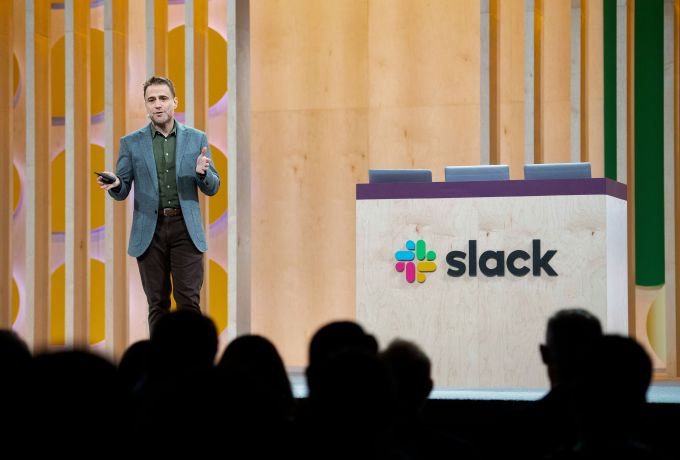
NOAH BERGER/AFP/Getty Images
Extra Crunch
Our premium subscription service had another week of interesting deep dives. TechCrunch’s Kate Clark wrote about Slack’s odd beginnings as a weird little online game studio called Tiny Speck and how some of the young startup’s storied investors weren’t thrilled about its dramatic pivot into enterprise messaging.
The Slack origin story: How a whimsical online game became an enterprise software giant
“With the support of more than $15 million in venture capital funding — all before the game began beta testing — Tiny Speck hired more than 40 employees, wrote hundreds of lines of code and concocted big dreams for its zany, whimsical and absurdist universe.”
Here are some of our other top reads this week for premium subscribers. This week TechCrunch writers talked a bit about SoftBank, and how to get VCs fighting over your startup idea…
- Fundraising 101: How to trigger FOMO among VCs
- Q&A with J Crowley, Head of Product at Airbnb Lux, on what makes a great PM
- The savage genius of SoftBank funding competitors
Want more TechCrunch newsletters? Sign up here.
Apple WWDC 2019: iOS 13, macOS 1015, Mac Pro expected to be announed
Apple will hold its Worldwide Developers Conference at its Cupertino campus in California to give a peak into what’s in store for Apple products this year. WWDC is when Apple releases its annual refreshes of operating systems for its range of products. We expect new versions of iOS, macOS, watchOS and maybe some new hardware as well. Apple also hosts important workshops and development sessions with thousands of attendees.
The opening keynote session will be held at the McEnery Convention Center in San Jose, California and is expected to start from 22:30 IST on Monday. You can catch the livestream on Apple's Events page in the official website which can be viewed on both Apple and non-Apple devices using the standard browsers. Here’s what to expect from WWC 2019 —
iOS 13 for iPhonesApple is expected to release the next-generation iOS, most likely to be named iOS 13 for iPhone and iPads. There are quite a few rumours around the upcoming version. Dark mode, for one is highly anticipated. It’s already present in macOS Mojave and might finally become a reality for iPhones and iPads as well. Having a dark mode will not only help the eyes, but also cut down on power consumption. There could also be a new Sleep Mode feature that mutes incoming notifications and reduces the lock screen brightness.
Along with that, there could be the expected revamps of Mail, Messages, Reminders and Health along with bug fixes and speed boosts.
iOS 13 for iPadsApple is expected to make people consider it’s “What’s a computer” slogan more seriously. The iPad is expected to get several new features that might make the experience using the tablets close to that of a PC. There could be support for mouse along with a keyboard, and the ability to display multiple windows in a tab view. Improvements to multitasking is also expected by allowing display of two windows of the same app side by side. The Files app could be further improved with gestures for undo/redo, selecting multiple items, etc. Lastly, a much-needed improvement to Find my iPhone app is reportedly on the works.
macOS 10.15Alongside the OS for iPhones, Apple is also expected to release the refresh to macOS, called macOS 10.15 at WWDC. There isn’t much known about the upcoming update but we might finally see the Apple’s universal apps in action. The aim is encourage developers to make a single app that will work across platforms on both iPhones and Macs. This could likely be another big boost towards Apple’s new focus on services as tightly integrating apps for PCs and smartphones which might lead to more apps for Macs and less work for the developer himself.
Death of iTunesLet’s admit it. Standing at 2019, the iTunes app is perhaps the least favourite Appleware. The all-in-one app for music, podcasts, movies and books is now an aged concept. And Apple is likely to dismantle the app to create separate apps for music, podcasts and books, alongside the new TV app for Macs that’s reportedly in the works.
Using iPad as an external displayThe iPad might get the ability to be used as an external display for MacBooks and iMacs with support for window snapping, Siri shortcuts and more. Screen Time for iPads is also expected to come this year. If Apple is able to pull off the display mirroring on iPads without a hitch, this could become yet another reason to check into the Apple ecosystem as a similar feature is not available on Windows yet.
tvOS and watchOSNew versions of tvOS and watchOS are also expected, but they are expected to be minor updates, save for a few exciting features. watchOS 6 might bring a overhaul of the operating system with the introduction of its own app stores which will let users download apps directly from their wrists. Apple is also expected to introduce a “Dose” app as reminders to take your meds as well as a “Cycles” to track menstrual cycles. Apart from that, calculator, voice memos, audiobooks, animojis are expected to be introduced to the Apple Watch. New watch faces including two extra-large faces showing things in jumbo fonts. There will be a “California” dial to imitate the looks of a classic watch but with a mix of Roman and Arabic numerals along with a watch face that looks like a sundial.
New hardware?Like every year, this time too there’s buzz around Apple announcing new hardware at WWDC. Well, Apple has been working on a high-end Mac Pro for a long time now and WWDC might be a good time to showcase what the Mac Pro will offer. But it’s still iffy whether Apple will eventually any new hardware at the event.
The US, the EU, and other superpowers have funneled nearly $81B towards supporting chip companies, the first wave of ~$380B earmarked by global governments (Bloomberg)
Bloomberg : The US, the EU, and other superpowers have funneled nearly $81B towards supporting chip companies, the first wave of ~$380B e...
-
Jake Offenhartz / Gothamist : Since October, the NYPD has deployed a quadruped robot called Spot to a handful of crime scenes and hostage...
-
Andrew Tarantola / Engadget : An adapted excerpt from the book “Your Computer Is on Fire”, on how voice assistants like Siri and Alexa al...

